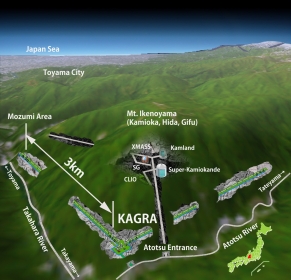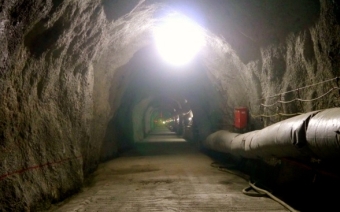|
|
|
|||||
|
|
|
|||||
KAGRA NEWS |
 |
|
KAGRA (Large Cryogenic Gravitational Wave Telescope) Project is
jointly promoted by Institute for Cosmic Ray Research (ICRR, the main
host), National Astronomical Observatory of Japan (NAOJ), High Energy
Accelerator Research Organization (KEK) and other member institutes as
an international collaboration.
|
|
March 31, 2014 Excavation of the KAGRA tunnel has been completed. |
|
At the end of March 2014, the excavation of the KAGRA tunnels, which span more
than 7 km, has been successfully completed. |
 KAGRA Project (presented by ICRR) |
Accelerating masses generate gravitational waves which are distortions in the
structure of spacetime and propagate like ripples through the
Universe. Although they were theoretically predicted from Einstein's
General Theory of Relativity about 100 years ago, there has not yet been
a direct detection of gravitational waves, mainly because their
interaction with matter is extremely weak. The first indirect evidence
for the existence of gravitational waves came from the discovery and
subsequent observations of a binary pulsar system by Hulse and
Taylor, for which they received Nobel prizes in 1993. A recent report from the BICEP2 project about the observation of a B-mode polarization component in the cosmic microwave background will, if confirmed, add more support for the existence of gravitational waves. With the indirect evidence piling up, the importance of directly detecting gravitational wave has never been higher. |
|
Until now, most astronomical observations have used electromagnetic
waves to extract information from sources. Since the generation
mechanism for gravitational waves is vastly different from the generation
mechanism for electromagnetic waves, gravitational waves carry unique information
about the sources which is otherwise unavailable to us. Direct detection of
gravitational waves from astronomical sources will give us rich
opportunities to explore the physics of extreme conditions, such as
the equation of state of neutron stars, the direct measurement of
black hole parameters, and the explosion mechanism of supernovae. |
| KAGRA is an L-shaped laser interferometric gravitational wave detector
with a 3 km baseline length being built in the underground site of
Kamioka mine in Gifu prefecture, Japan. Using this interferometer, we
try to detect tiny distortion of spacetime as small as one 10 billionth of
the diameter of a hydrogen atom. In order to achieve such an extreme
sensitivity, external disturbances such as ground vibrations have to
be eliminated. The ground vibrations of the Kamioka-mine are about 100
times smaller than those of Tokyo. This seismically quiet environment
is essential for the success of KAGRA. This is why we excavated long
tunnels with a total length of 7,697 m. |
 inside the tunnel (presented by ICRR) |
|
|
Once operational, KAGRA is expected to open a completely new
observational window to the Universe. |
|
The National Astronomical
Observatory of Japan (NAOJ) is one of the core institutes of the KAGRA
project, together with the Institute for Cosmic Ray Research,
University of Tokyo and the High Energy Accelerator Research
Organization, promoting the construction and operation of KAGRA. The
completion of the tunnel excavation marks an important milestone for
the construction of KAGRA. For more details, please refer to the press
release from the University of Tokyo. |